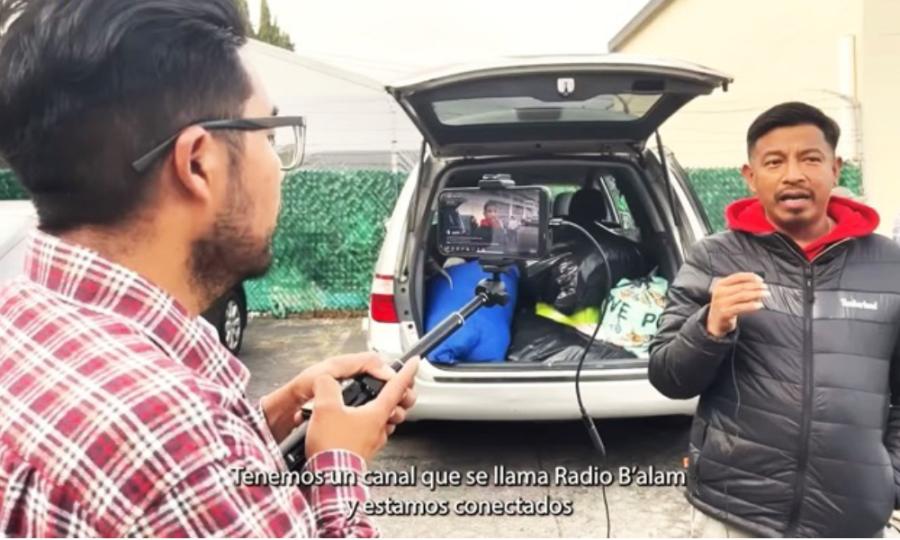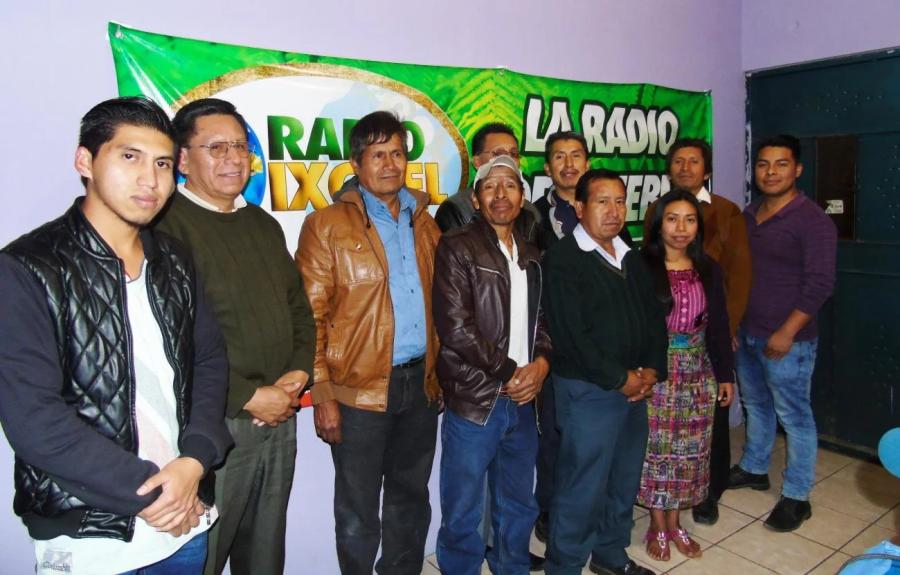
Photo: View of La Danta pyramid, the largest temple at El Mirador site and possibly in the world, reaching 79 metres (259 ft) high. Photo by Dennis Jarvis on Flickr.
By Jesus Nazario and Jess Cherofsky
On June 28, members of the Maya group Tujaal, a word in Maya K’iche’ meaning “tender maize,” released a statement opposing a proposed U.S.-based project seeking to privatize archaeological sites in the Maya Biosphere Reserve in Petén, Guatemala. Inside the protected bioreserve sits El Mirador, a 2,450 square mile basin and Maya cultural site, and a site of contention between Maya Indigenous communities and U.S.-based archaeologists.
The Mirador-Calakmul Basin is part of the Maya Biosphere Reserve and comprises 1.6 million acres of rainforest covering areas across Southern Mexico and Northern Guatemala. Within the area are remains of over 51 pre-hispanic Maya cities. El Mirador, one of the cities, represents for Maya Peoples “our historical and cultural legacy,” says Maya K’iche’ archaeologist Iyaxel Cojtí Ren, who is currently finishing a postdoctoral fellowship at the Dumbarton Oaks Research Library. “They are sacred spaces, vital to the practice of Maya spirituality.”
The “Architect”
In late 2019, bill S.3131 was introduced to the 116th United States Senate by Democratic Senator Tom Udall of New Mexico as the “Mirador-Calakmul Basin Maya Security and Conservation Partnership Act of 2019.” The contested bill’s self-proclaimed architect is Richard Hansen, a Utah-based archaeologist. Senators James Risch, Republican of Idaho, and Roger Wicker, Republican of Minnesota, are co-sponsoring the bill, which seeks to privatize and invest up to 120 million dollars in the Mirador-Calakmul Basin through “continued tropical forest and archaeological scientific research, law enforcement, and sustainable tourism.”
Hansen has studied El Mirador for almost 40 years. In a recent VICE video report, Hansen claims that sustainable tourism, as he has envisioned it, is the only way to ensure the protection of the Maya Biosphere Reserve. The U.S. Senate bill states in section 2 that there has been an increase in “trafficking of timber, gold, wildlife, and other resources” within the protected reserve as a result of “little central government control or law enforcement.” Hansen’s plans involve “a privately managed resort, with hotels, restaurants, and guided tours,” as well as a train to allow access to remote areas.
"You should see the opposition [to the project]...That's my one of my criticisms of the Guatemalans—there’s no vision," Hansen said when asked about why El Mirador was not a tourist destination.
A Vision of Biocultural Community Management
Yet local Maya and mestizo communities have a complex and thriving land management program that meets their environmental goals and provides economic benefits to their communities. The Association of Forest Communities of Petén (ACOFOP) was founded in 1995 as a cooperative in charge of managing 500,000 hectares of the Maya Biosphere Reserve through a community forestry model. As of 2016, ACOFOP comprised 23 community organizations, “representing over two thousand families and providing benefits to an estimated forty thousand people.”
The communities live within the reserve, carrying out sustainable production and harvesting of mahogany and cedar for timber, latex, allspice, nuts, and xate, an ornamental palm. Their access to the reserve depends on concessions from the government, hard-fought through “mass protests” in the 1990s against both the government and western conservationists. This is the 23rd year of a 25-year concession for ACOFOP, and the ACOFOP land managers’ vision is clear: community governance results in environmental conservation, biodiversity protection, and sustainable development by and for communities, and they have a 23-year track record and scientific studies to prove it.
As a tourism coordinator in Carmelita, a community next to El Mirador, Juan Carlos Marín represents ACOFOP and works within the forest concessions. Marín says that, during the 23 years of practicing sustainable forestry, the rate of deforestation has been less than one percent in the concession areas. As of 2016, the Rainforest Foundation reported the deforestation rate in the concessions to be 86% less than in government protected areas.
Indigenous Peoples have the right to conserve and tend their own lands, and they are also the best equipped to do so. In an interview with Cultural Survival staff, Jorge Emilio Soza of the Integral Forest Association (Asociación Forestal Integral) and native of San Andrés Peten points out that in Guatemala’s case, the nation’s Peace Accords of 1996 stipulate community land management. A 2014 report by Rights and Resources Initiative reported, “[I]t is believed that strong community forest rights [in Brazil] could prevent 27.2 million hectares of deforestation by 2050, equal to three years’ worth of emissions from all Latin American and Caribbean countries. Research in several countries also shows that deforestation rates inside indigenous and community forests with strong legal recognition and government protection are significantly lower than in forests outside these areas. Further, Indigenous Peoples and local communities have effectively protected their environment for thousands of years with little or no outside financial incentive, and limited government recognition.” The report goes on to note that areas benefiting from community management were “‘even more effective’ than strictly protected areas at reducing the incidence of fire.” The presence of fewer fires is understood to imply less deforestation.
The Maya Biosphere Reserve provides a case in point. The cooperative communities’ powerful environmental monitoring system has radically reduced forest fires; while the community-managed concessions comprise 16% of the Reserve, they contain only 1% of all forest fires. Soza applauds how community patrols, trained in drone use, gather data to protect their lands. He highlights how annual forest fires only occur in areas of Petén where community organizations are absent. “Thanks to the management [in the concessions], El Mirador has that support that guarantees that there won’t be an interruption in soil use, there won’t be forest fires. Why? Because those communities are what provides the buffer zone to prevent all those disasters.”
Studies in 2004 and 2005 also found that deforestation was less than prior to the formal establishment of community management and that biodiversity has increased. Evidence also suggests, contrary to Hansen’s and the U.S. Senate bill’s allegation, that trafficking is actually less likely to be associated with community managed lands. Soza says, “The communities know we are managing the forest well, through a forest management certification which guarantees at the global level...that resource management is being done technically and scientifically.” This also serves as a guarantee to the Guatemalan government.
After the 25-year concession ends in 2022, it will be up for renewal and thus at risk. Hansen told Guatemalan officials that no one would invest in his project if the concessions continued; in the next breath, he emphasized to them how “great it would be for you” if they supported his project.
“These kinds of projects [like Hansen’s] have always been proposed to political leaders; they have never been presented to the community,” says Marín. “Our grandparents have lived here, our parents have lived here, and now we live here.” Consultation with the communities is part of the internationally recognized right to Free, Prior, and Informed Consent before any projects that affect Indigenous Peoples on their lands. It is enshrined in the UN Declaration on the Rights of Indigenous Peoples and other international agreements. Hansen has not complied with this obligation.
"Should the protected areas in El Mirador be privatized, local communities may lose access they have had to the Maya Biosphere via forest concessions,” says Cojtí Ren. “That is the fear, that they will be excluded and become employees of the planned tourism enterprise; they would no longer be protagonists in the [Mirador-Calakmul Basin].”
“Of course El Mirador is important to us; it is the natural and cultural patrimony of all Guatemalans," says Soza. "By not renewing the [forest] concessions there could be social chaos because there would not be the opportunity for income for the families in the communities. This would have a huge impact.”
A way to overcome current limitations in sustainable development is to conduct evidence-based environmental studies in the Biósfera Maya to better inform sustainable development policies, and ensure that the communities living in Peten be included in eventual decision making processes, Marín says.
“I think this is ultimately a case of sovereignty because it should not be possible for someone to come and bypass all of our laws, primarily the laws regarding protected areas,” Marín said. “The train [that Hansen is proposing] may be an option but it needs to be proven to be the best option.”
Resistance
In response to Hansen’s plan, S.3131, the members from the group Tujaal position themselves in direct opposition. Their statement, titled “The Maya City El Mirador is not up for negotiation, sale, or dispute. It is respected,” discusses how the local Maya peoples living within the protected biospheres in Guatemala, where El Mirador is situated, will lose their livelihoods, should the bill pass. The group has made five specific demands:
-
For the three U.S. Senators sponsoring the bill S.3131 to not move forward with the bill.
-
For Richard Hansen to cease his studies in El Mirador and for proper repatriation of Maya artifacts held in private collections across the world.
-
For Richard Hansen to disseminate his research findings, since such information has not been published nor discussed with Maya communities since Hansen began his research in El Mirador in 2002.
-
For Maya communities to not support Guatemalan politicians that are in favor of supporting the S.3131 bill.
-
For an alliance between all Maya elders, healers, authorities, and governments as a whole to oppose and protect the Maya Biosphere Reserve.
Cultural Survival is in solidarity with the Maya and mestizo communities of the Mirador-Calakmul Basin and their right to sovereign management of their lands. We believe it should be up to the peoples living in the Mirador-Calakmul Basin to decide how to govern their lands, be it through the current communal forest concessions or other forms of management. In either case, decisions should be locally determined and always include free, prior, and informed consent when projects are proposed by outside groups. Nation-states should aid in Indigenous Peoples’ self-determination. We reiterate our support and have signed on to an open letter by Tujaal denouncing the S.3131 project.
A petition has been created with over 200,000 supporters in opposition of bill S.3131. In addition to gathering support against the bill, the petition also asks supporters to reach out to their respective elected officials to voice their concerns over the bill.



